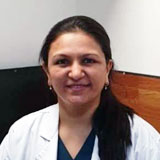Screen Time, Desk Jobs, and Breast Cancer: The Deadly Equation You Can Change

Screen Time, Desk Jobs, and Breast Cancer: The Deadly Equation You Can Change
Dr. Khyati Dedhia
India’s Leading Breast Imaging Expert
 Modern Comforts, Hidden Risks
Modern Comforts, Hidden Risks
Hours of sitting at work or home, scrolling through emails or social media, and binge-watching the latest series have become the daily norm for many Indian women juggling many responsibilities- as working professionals and homemakers.
Such sedentary lifestyles are linked to obesity, hormonal imbalances, and inflammation—all of which are risk factors for breast cancer. A recent meta-analysis (a study of many studies) found that women leading sedentary lives have a 15.5% higher risk of developing breast cancer compared to their more active counterparts.[1] This connection is even more striking in urban India.[2]
Here’s why: prolonged inactivity leads to weight gain and disrupts the body’s ability to regulate estrogen levels and insulin resistance, which can fuel cancer cell growth and inflammation. Amplified by rising screen time and reduced physical activity, this has become a significant health challenge for Indian women.
How can you change the deadly equation?
Let’s discuss two simple health habits you can build to stay safer:
- A daily mobility routine, and
- A yearly mammography routine.
1. Start a Simple Mobility Routine Today
Small changes in your daily routine can significantly reduce your breast cancer risk. Try these exercises every day to break long sitting periods:
The Five-Minute Mobility Booster[3],[4]:
- Chair Stretch: Sit upright. Stretch your arms overhead, interlocking your fingers. Hold for 20 seconds.
- Leg Lifts: While seated, lift one leg straight out, hold for 10 seconds, then switch legs. Repeat 5 times per leg.
- Desk Push-Ups: Stand facing your desk. Place your palms on the edge and perform 10 push-ups.
- Standing March: Stand up and march in place for 2 minutes.
- Side Twists: Stand with your feet apart. Place your hands on your hips and twist side to side. Repeat 10 times.
Perform this routine every 2-3 hours to keep your body active and your risk factors at bay.
Even simple physical activity like moderate-intensity walking regularly can reduce the risk of breast cancer.
2. Why Mammograms Matter—And Why 3D Mammography is a Game Changer
One of the most dangerous misconceptions is that mammograms aren’t necessary unless there are noticeable symptoms. Breast cancer often develops silently, with no obvious signs in its early stages.
There is no way to prevent breast cancer. Early detection is the best protection. Routine mammograms can dramatically improve survival rates by detecting tumours before they spread or grow large and unsafe enough to be felt by self-exam.
Here’s how the latest 3D mammography outshines the earlier technologies in keeping you safer:
- Enhanced clarity: It provides detailed, three-dimensional images, making it easier to detect small tumours by using innovative technology designed to produce clear images of the breast tissue, layer by layer.[5]
- Reduced recalls: 3D mammography exams help considerably reduce recall rates for additional tests.[6]
- Better detection: 3D mammography exams enable the detection of more cancer cells[7], and 20–65% more invasive breast cancers than 2D alone, with an average increase of 41%.[8]
- Helps high-risk women more: 3D mammography is beneficial in high-risk women, i.e., including those with:
- Changes or lumps in the breasts
- A family history of breast or ovarian cancer[9]
- Dense breast tissue (nearly half of all women above the age of 40 have dense breasts)[10]
- A previous diagnosis of breast disease
This means two simple things: Earlier detection than ever before and less anxiety about unnecessary further testing.[11]
Routine mammograms often lead to the reassuring news that ‘all is well.’
In Conclusion:
Understanding the dreadful consequences of late breast cancer diagnosis can empower you to stay breast-healthy. Here are some general tips for your action:
- Never miss your daily exercise and annual mammogram: Both daily mobility exercises and yearly mammograms are vital. Mammograms can detect breast cancer early when it is most treatable. Don’t rely on breast self-exams or other modalities. Make it a priority to schedule your yearly screening even if you feel perfectly healthy.
- Select the right mammography center: You may have many options at your place to get a mammogram done, such as a diagnostic lab, a hospital, or a dedicated breast clinic. How do you select one among all available choices? Here are three easy steps to help you choose the right mammography center.
- Overcome your mammography anxiety if you have any: If you feel anxious before a mammography session, you are not alone. Your stress could be due to either it being your first mammogram, your fear of discovering cancer, myths harboured in your mind, or your past uncomfortable experience. Whatever your reason, it’s important to remember that mammograms save lives, and here are seven tips to help you relax before your next mammogram.
- Stay informed. Stay healthy: Your family needs you forever. Your health is as important to them as it is to you. Keep up with the latest research and reliable information on mammography and breast health. Follow healthy routines and medical advice to protect yourself and your loved ones.
- Get your mammogram today: Early detection protects best against breast cancer. 3D mammography gives you the best chance of catching breast cancer early when it’s most treatable. So, don’t wait or don’t rely on self-exams alone. If you are eligible for breast screening either by age (40 years and above) or due to high-risk factors such as family history (in which case even if you are younger than 40 years), subscribe today to an annual screening mammography plan at a center near you and never miss your test—a simple ritual that can save your life!
It’s not just about you – it’s about being there for your loved ones.
Take charge of your health in 2025 and encourage other women to do the same.

Dr Khyati Dedhia
Consultant Radiologist,
Women’s Imaging (Mammography & Ultrasound) Specialist,
Nidan World Healthcare,
Ghatkopar West, Mumbai.
- Lee J, Lee J, Lee D, Kim H, Kang M. Sedentary work and breast cancer risk: A systematic review and meta‐analysis. Journal of Occupational Health. 2021;63(1). doi: https://doi.org/10.1002/1348-9585.12239
- Vaitheeswaran Kulothungan, Ramamoorthy T, Krishnan Sathishkumar, et al. The burden of female breast cancer in India: estimates of YLDs, YLLs, and DALYs at national and subnational levels based on the national cancer registry program. Breast cancer research and treatment. Published online March 4, 2024. doi: https://doi.org/10.1007/s10549-024-07264-3
- Nelson AG, Kokkonen J. Stretching anatomy. Human Kinetics Publishers; 2021.
- Yeom HA, Keller C, Fleury J. Interventions for promoting mobility in community-dwelling older adults. Journal of the American Association of Nurse Practitioners. 2009 Feb 1;21(2):95-100.
- Friedewald SM, Rafferty EA, Rose SL, Durand MA, Plecha DM, Greenberg JS, Hayes MK, Copit DS, Carlson KL, Cink TM, Barke LD, Greer LN, Miller DP, Conant EF. Breast cancer screening using tomosynthesis in combination with digital mammography. JAMA. 2014 Jun 25;311(24):2499-507. doi: 10.1001/jama.2014.6095. PMID: 25058084. https://pubmed.ncbi.nlm.nih.gov/25058084/
- Rose SL, Tidwell AL, Bujnoch LJ, Kushwaha AC, Nordmann AS, Sexton R Jr. Implementation of breast tomosynthesis in a routine screening practice: an observational study. AJR Am J Roentgenol. 2013 Jun;200(6):1401-8. doi: 10.2214/AJR.12.9672. PMID: 23701081. https://pubmed.ncbi.nlm.nih.gov/23701081/
- Skaane, Per, et al. “Comparison of digital mammography alone and digital mammography plus tomosynthesis in a population-based screening program.” Radiology 267.1 (2013): 47-56. https://pubs.rsna.org/doi/full/10.1148/radiol.12121373
- Friedewald SM, Rafferty EA, Rose SL, Durand MA, Plecha DM, Greenberg JS, Hayes MK, Copit DS, Carlson KL, Cink TM, Barke LD, Greer LN, Miller DP, Conant EF. Breast cancer screening using tomosynthesis in combination with digital mammography. JAMA. 2014 Jun 25;311(24):2499-507. doi: 10.1001/jama.2014.6095. PMID: 25058084. https://pubmed.ncbi.nlm.nih.gov/25058084/
- https://www.canceraustralia.gov.au/sites/default/files/publications/breast-cancer-risk-factors-review-evidence/pdf/rfrw-breast-cancer-risk-factors-a-review-of-the-evidence_1.15.pdf accessed 30 Nov 2024
- https://www.cancer.gov/types/breast/breast-changes/dense-breasts accessed 30 Nov 2024
- Zuley ML, Bandos AI, Ganott MA, Sumkin JH, Kelly AE, Catullo VJ, Rathfon GY, Lu AH, Gur D. Digital breast tomosynthesis versus supplemental diagnostic mammographic views for evaluation of noncalcified breast lesions. Radiology. 2013 Jan;266(1):89-95. doi: 10.1148/radiol.12120552. Epub 2012 Nov 9. PMID: 23143023; PMCID: PMC3528971. https://pubmed.ncbi.nlm.nih.gov/23143023/
